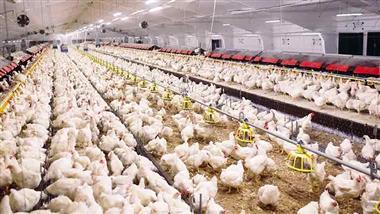by Dr. Joseph Mercola, Mercola:

STORY AT-A-GLANCE
- Chicken feces, or chicken litter, and other animal waste from concentrated animal feeding operations (CAFOs) is commonly used as fertilizer, including for organic crops
- CAFO waste used as fertilizer is contaminated with pathogens, including bacteria, fungi, viruses, antibiotics, antibiotic-resistant genes, growth hormones, heavy metals and pesticides
TRUTH LIVES on at https://sgtreport.tv/
- In the U.S., feces from broiler chickens were contaminated with antibiotic-resistant E. coli, with genes resistant to more than seven antibiotics, including amoxicillin, ceftiofur, tetracycline and sulfonamide
- A meta-analysis concluded “direct land application of chicken litter could be harming animal, human and environmental health”
- The overwhelming presence of CAFOs in the state of North Carolina prompted a civil rights complaint on behalf of residents in three counties
Farmers have used manure as a natural, nutrient-rich fertilizer for thousands of years. In fact, there’s evidence that early farmers used manure to fertilize cereal grains and pulse seeds up to 7,900 years ago. They likely noticed enhanced crop growth in areas where manure naturally accumulated, then tried the method in other areas.1
Today, many farmers still depend on manure to help their crops grow. This includes organic farmers2 and those using permaculture and regenerative methods.3 When chickens are raised on pasture, their manure is spread across the land and worked into the soil naturally via pecking and scratching.4
This beneficial practice that works in concert with nature bears little resemblance to the use of poultry litter — or chicken feces, sometimes mixed with urine, sawdust, feathers and other materials — and other animal waste from concentrated animal feeding operations (CAFOs) as fertilizer. Yet, this latter practice is common, even among some organic farms.5
Chicken Litter Contains Bacteria, Viruses and Other Pathogens
Chicken litter used as an organic fertilizer is considered “the cheapest and most environmentally safe method of disposing of the volume generated from the rapidly expanding poultry industry worldwide.”6
But a review, published in the International Journal of Environmental Research and Public Health, raises an important point — “little is known about the safety of chicken litter for land application and general release into the environment.”7
The research team, from Kyambogo and Makerere Universities in Uganda and the University of Florida, set out to remedy this. They conducted a meta-analysis of technical reports, conference proceedings, peer-reviewed journal articles and internet texts, noting that the available data was “scattered and disjointed” making it difficult to access and interpret.
They consolidated the data they did find, however, revealing that “direct land application of chicken litter could be harming animal, human, and environmental health.”8 The review revealed, for instance:9
| Counts of pathogenic strains of E. coli and coliform bacteria exceeded the maximum permissible limits for land application | In Australia, broiler litter was contaminated with Actinobacillus bacteria |
| Avian influenza, capable of infecting poultry, humans and wild animals, was also detected | In the U.S., broiler litter was contaminated with antibiotic-resistant E. coli, with genes resistant to more than seven antibiotics, including amoxicillin, ceftiofur, tetracycline and sulfonamide |
| Salmonella, E. coli, Actinobacillus, Campylobacter and coliform bacteria were the most prevalent bacterial contaminants | Pathogenic fungal contaminants were also commonly found in chicken litter, including sources of aflatoxins linked to cancers and liver damage |
Pesticide Residues, Antibiotics, Heavy Metals Also in Manure
The massive quantities of manure flowing from CAFOs amounts to a toxic sludge of contaminants, spread on fields used to grow even organic food.
“The key safety concerns of chicken litter are its contamination with pathogens, including bacteria, fungi, helminthes, parasitic protozoa, and viruses; antibiotics and antibiotic-resistant genes; growth hormones such as egg and meat boosters; heavy metals; and pesticides,” the researchers explained.10
Chicken litter contains a “vast array” of antibiotics and heavy metals, their meta-analysis showed, including “high concentrations” of cadmium, lead, arsenic and mercury that “pose serious health risks to animals, plants and environmental health.”11
Pesticides, including dioxins, furans, polychlorinated biphenyls and polycyclic aromatic hydrocarbons, also contaminate chicken litter, as do growth and sex hormones like estrogen and testosterone. Growth hormones have a harmful effect on reproduction in fish and other aquatic organisms, and may persist in the environment for more than two years after they’re excreted in chicken litter.
“This persistence increases the potential of the hormones reaching surface water bodies through runoff,” according to the team.12 Further, they noted, “The chlorinated antibiotic and pesticide residues detected in chicken litter are worryingly high. These chemicals are persistent, carcinogenic, and release dioxin when contaminated litter is burnt.”13
Regarding antibiotics, fluoroquinolones, sulfonamides and tetracyclines were the classes most widely detected. While some antibiotics degrade in soil within about 30 days, others persist and may harm microorganisms and soil fertility. Some antibiotics can also be absorbed into food crops, like green onions, cabbage and corn, from the soil. The analysis noted:14
“The presence of antibiotics, especially those that kill pathogens in chicken litter and are broad spectrum, may distort major biological processes in soil upon application of the litter, including development of antibiotic resistance, which can affect humans, livestock, fish, and wildlife … Human consumption of antibiotics-contaminated foods can increase antibiotic resistance, leading to food poisoning or allergies.”
Despite this, they added, “There are no standards set specifically for chicken litter for most of its known contaminants. Even where standards exist for related products such as compost, there is wide variation across countries and bodies mandated to set standards for safe disposal of organic wastes.”15



